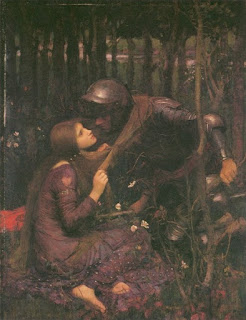In the Georgette Heyer novels I love so much there are several mentions of the dangerous Lord Byron, but he had several contemporaries, known as the Romantic Poets, not all of whom had Byron’s entrée to ton society. One such was John Keats (1795-1821), humbly born, and orphaned relatively young. He took up medicine as a career, but his love of beauty and literature had found expression in poetry by his late adolescence. Inspired by Spenser’s Faerie Queen, he entered “a new world of bright colour and honied language, of romantic adventure and chivalric devotion far above the level of actual life,” according to one biographer, Aileen Ward, and wrote his first poem.
Keats' first poem was published in 1816, and my favorite, La Belle Dame San Merci, was written in 1819, early in his sadly short career (just two years later, he died of tuberculosis, the family disease). Depressed by the recent death of his brother, and inspired by Dante, Chaucer, Robert Burns, and others, Keats depicts a lonely and despairing knight who has been enchanted by a mysterious woman and then rejected.
I
O
what can ail thee, knight-at-arms,
Alone
and palely loitering?
The
sedge has wither’d from the lake,
And
no birds sing.
Many poets embrace themes of love and loss but in La Belle Dame Sans Merci Keats created images that would not only be remembered by readers but
also fueled the imagination of many artists.
The best known is this 1893 painting by Pre-Raphaelite John William Waterhouse:
In the poem, the
contrast between the pale knight and the heartless temptress is drawn
carefully. In the first three stanzas,
the “haggard” knight is introduced, and in the following nine, he tries to
explain what happened to him. At first
he tried to assert authority by making her a garland and setting her on his
steed. She then takes over by feeding him wild honey, and
takes him to her “elfin grot” where he is in her thrall. He kisses her but is distracted by seeing the
shades of her former victims, then wakes up alone and disconsolate. He tells the reader he is loitering, clearly
in hope that the lady will reappear and take him back to her enchanted grotto, but the reader knows she will not return.
|
I
O WHAT can ail thee, knight-at-arms,
|
|
Alone and palely loitering?
|
|
The sedge has wither’d from the lake,
|
|
And no birds sing.
|
|
|
|
II.
O what can ail thee, knight-at-arms!
|
|
So haggard and so woe-begone?
|
|
The squirrel’s granary is full,
|
|
And the harvest’s done.
|
|
|
|
III.
I see a lily on thy brow
|
|
With anguish moist and fever dew,
|
|
And on thy cheeks a fading rose
|
|
Fast withereth too.
|
|
|
|
IV.
I met a lady in the meads,
|
|
Full beautiful—a faery’s child,
|
|
Her hair was long, her foot was light,
|
|
And her eyes were wild.
|
|
|
|
V.
I made a garland for her head,
|
|
And bracelets too, and fragrant zone;
|
|
She look’d at me as she did love,
|
|
And made sweet moan.
|
|
|
|
VI.
I set her on my pacing steed,
|
|
And nothing else saw all day long,
|
|
For sidelong would she bend, and sing
|
|
A faery’s song.
|
|
|
|
VII.
She found me roots of relish sweet,
|
|
And honey wild, and manna dew,
|
|
And sure in language strange she said—
|
|
“I love thee true.”
|
|
|
|
VIII.
She took me to her elfin grot,
|
|
And there she wept, and sigh’d fill sore,
|
|
And there I shut her wild wild eyes
|
|
With kisses four.
|
|
|
|
IX.
And there she lulled me asleep,
|
|
And there I dream’d—Ah! woe betide!
|
|
The latest dream I ever dream’d
|
|
On the cold hill’s side.
|
|
|
|
X.
I saw pale kings and princes too,
|
|
Pale warriors, death-pale were they all;
|
|
They cried—“La Belle Dame sans Merci
|
|
Hath thee in thrall!”
|
|
|
|
XI.
I saw their starved lips in the gloam,
|
|
With horrid warning gaped wide,
|
|
And I awoke and found me here,
|
|
On the cold hill’s side.
|
|
|
|
XII.
And this is why I sojourn here,
|
|
Alone and palely loitering,
|
|
Though the sedge is wither’d from the lake,
|
|
And no birds sing.
|
|
|
|
|
|
|


3 comments:
This poem has a strong connection to Pamela Dean's Tam Lin.
I never realized it was reading The Faerie Queen that inspired Keats to be a poet! I must add it to my reading list.
Thank you so much for joining in the tour with your post, Constance! :)
Lovely idea for a blog tour! I think I'll feature a Keats poem on my blog too...
Post a Comment